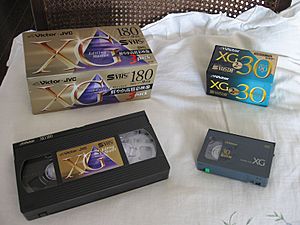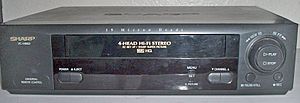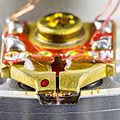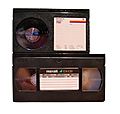VHS facts for kids
VHS, which stands for Video Home System, was a very popular way to record and watch videos at home. It uses a special tape inside a plastic box called a videocassette. You could record TV shows or home videos onto these tapes and then play them back on a television using a machine called a VCR (which stands for Video Cassette Recorder).
In the 1980s and 1990s, VHS was so common that when people said "videocassette" or "video," they usually meant a VHS tape. You could record videos using a video camera that used VHS-C tapes (a smaller version of VHS) or record TV shows with a VCR.
The Victor Company of Japan (JVC) created VHS in 1976. It became a huge success for home video recording. However, today, newer technologies like DVDs (Digital Versatile Discs) and Blu-ray discs have replaced VHS. These newer discs offer better picture quality, are easier to use, last longer, and the players and discs are cheaper to make. Because of this, VHS VCRs, blank tapes, and most pre-recorded VHS movies are no longer made.
Contents
How VHS Came to Be
Early Video Recorders
Before VHS, many companies tried to create ways to record video on tape. The first successful video tape recorder (VTR) was the Ampex VRX-1000, released in 1956. It was incredibly expensive, costing about $50,000 at the time (which would be over $400,000 today!). Because of its high cost, only professional TV stations and businesses could afford to use it.
Kenjiro Takayanagi, a pioneer in television, worked at JVC. He believed his company could make money by creating more affordable VTRs for people in Japan. By 1959, JVC had developed its own two-head video tape recorder. In 1964, they released the DV220, which was their main VTR for many years.
In 1969, JVC worked with Sony and Matsushita Electric (who owned Panasonic) to create a standard video recording format for homes in Japan. They developed the U-matic tape format in 1971. U-matic became a standard for businesses and some TV broadcasting. However, it was still too expensive for most families, and the tapes could only record short videos.
Soon after, Sony and Matsushita decided to work on their own video formats. Sony started developing Betamax, and Matsushita worked on VX.
Developing the VHS System
In 1971, two JVC engineers, Yuma Shiraishi and Shizuo Takano, started a team to design a VTR specifically for home use. They made a list of important goals for their new VHS system:
- The machine needed to work with any regular TV.
- The picture quality on the TV had to look like a normal TV broadcast.
- The tape needed to record at least two hours of video.
- Tapes recorded on one VHS machine should play on other VHS machines.
- The system should be able to connect to other devices, like a video camera or another recorder.
- The recorders should be affordable, easy to use, and cheap to fix.
- JVC needed to be able to make many of these machines quickly, using parts that could be easily swapped between different models.
In 1972, the video recording industry in Japan faced financial problems, and JVC had to cut costs. They stopped funding the VHS project. But Takano and Shiraishi believed in their idea and continued working on it by themselves. By 1973, they had built a working prototype. Their hard work eventually led to the successful launch of VHS.
Different Types of VHS
Over the years, several different versions of VHS were developed to offer better quality or smaller sizes:
- VHS HQ (High Quality) improved the picture slightly. Tapes recorded in HQ could still be played on older, non-HQ VCRs.
- Linear stereo added two audio tracks for stereo sound, instead of just one for mono sound.
- VHS HI-FI brought much better stereo sound, almost as good as a CD. These tapes could still play on regular VHS VCRs, but without the high-quality sound.
- VHS-C was a smaller VHS cassette, often used in camcorders. The tape inside was the same as a full-size VHS tape. You could play and record VHS-C tapes in a regular VHS VCR using a special adapter. These tapes usually held about 30 minutes of video.
- Super VHS (S-VHS) offered a much clearer picture, similar to a Laserdisc or DVD. However, S-VHS tapes would not play correctly on a standard VHS VCR. There was also a smaller version for camcorders called S-VHS-C.
- D-VHS (Data VHS or Digital VHS) was a digital version that could record in high definition (like 720p or 1080i). It could also be used to back up computer data. Its video quality and storage capacity were similar to Blu-ray.
- W-VHS was an analog high-definition format that recorded in 1035i.
- Digital-S or D-9 was a digital VHS version made for professional use, like TV broadcasting. It used a different type of tape.
Images for kids
-
The inside of a modern VHS VCR showing the drum and tape.
See also
 In Spanish: VHS para niños
In Spanish: VHS para niños














